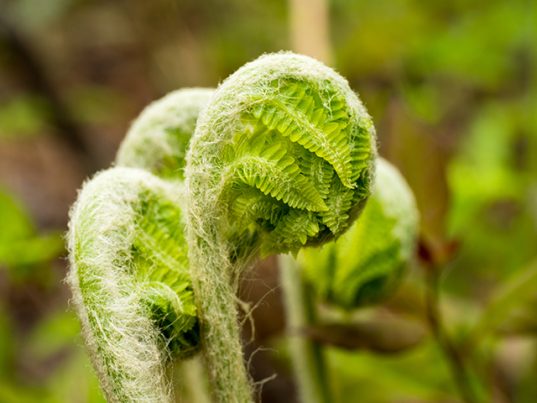
Fiddlehead – sources, health benefits, nutrients, uses and constituents at NaturalPedia.com
Tuesday, August 15, 2017 by Frances Bloomfield
http://www.naturalpedia.com/fiddlehead-sources-health-benefits-nutrients-uses-and-constituents-at-naturalpedia-com.html

Fiddleheads, also known as fiddlehead greens, are the tightly curled fronds of young ferns, most often ostrich ferns (Matteuccia struthioreris). The name refers to their furled appearance that resembles the head of a fiddle or violin. Fiddleheads are harvested and consumed as vegetables, particularly in North America. They’re especially popular in Maine and New Brunswick in the United States and Canada, respectively, and have been incorporated into the diets of people in New Zealand and Australia. Fiddleheads are surprisingly nutrient-dense plants that can yield numerous health benefits when consumed frequently.

List of known nutrients
At just 34 calories per a 100-gram serving, fiddleheads are low-calorie vegetables with an impressive nutritional profile that includes a bounty of essential vitamins and minerals, such as:
- Copper
- Iron
- Manganese
- Omega-3 Fatty Acids
- Omega-6 Fatty Acids
- Phosphorus
- Potassium
- Protein
- Vitamin A
- Vitamin B1 (Thiamin)
- Vitamin B2 (Riboflavin)
- Vitamin B3 (Niacin)
- Vitamin C
Fiddleheads are loaded with copper, manganese, and vitamins A and B3, and can easily help meet the recommended daily intake for these nutrients.
Medicinal uses for fiddleheads
Fiddleheads can reduce the symptoms of various health conditions, such as:
- Anemia
- Cancer
- Heart Attack
- High Blood Pressure
- Inflammation
- Macular Degeneration
- Migraines
- Night Blindness
- Osteoporosis
- Stroke
The abundance of vitamin A in fiddleheads makes them an excellent food choice for maintaining good eyesight and for preventing illnesses that arise from weakened vision, namely macular degeneration and night blindness.
As a rich source of manganese, fiddleheads can lower the risk of osteoporosis as well. Manganese assists in the formation of bone regulatory hormones and bone metabolism enzymes. In addition, manganese works hand-in-hand with the minerals calcium, zinc, and copper in strengthening the bones and making them less prone to breakage and loss.
The iron content in fiddleheads contribute to them being a decent preventive measure against anemia, which arises from iron deficiency.
Fiddleheads have a fair amount of potassium and almost no sodium, meaning they can help against high blood pressure. Potassium is a vasodilation mediator, and so it ensures that blood vessels dilate properly.
Body systems supported by fiddleheads
Fiddleheads are believed to be good for a number of the body’s systems and organs, most notably:
- Blood
- Cardiovascular System
- Digestive System
- Immune System
- Ocular System
- Skeletal System
Because fiddleheads are dense in vitamins A and C, they can boost the immune system and protect the body from infection. Moreover, both vitamins have antioxidant effects that protect the body from the damages caused by free radicals.
In addition to potassium, fiddleheads contain the heart-healthy nutrient vitamin B3, which can play a role in decreasing the amount of low-density lipoprotein (LDL) or bad cholesterol in the body while simultaneously raising high-density lipoprotein (HDL) or good cholesterol.
Ways to use fiddleheads
Fiddleheads have a unique and natural grassy flavor that can be brought out by sauteing, steaming, stir frying, baking, and frying. They do well as a major component of most vegetable-heavy recipes, or as a side dish. Their flavor makes it so that a bit of salt and pepper will often suffice as seasoning. Take care not to overcook fiddleheads, as overcooking will make them too soft.
Note: uncooked fiddleheads taste very bitter and shouldn’t be consumed raw, not just because of their bitter flavor but also because raw fiddleheads may upset the stomach. Fiddleheads that haven’t been cooked or stored properly can cause food poisoning.
Where to learn more
- Blend edible wild weeds into green smoothies
- Fiddleheads: the antioxidant-rich, healthy vegetable with an unusual name
- Nutrient-rich wild fiddleheads are a spring delicacy
Summary
Fiddleheads contain a diverse range of nutrients that make them truly healthy vegetables. They can reduce the risks of macular degeneration, anemia, high blood pressure, and osteoporosis. They can support vision, heart, and bones. Raw fiddleheads, as well as fiddleheads that have not been properly cooked, can have harmful health effects.
Sources include:
Nutrition-And-You.com
HealthBenefitsTimes.com
DoveMed.com
HealthyFocus.org
TheSpruce.com
Tagged Under: Tags: Fiddleheads





